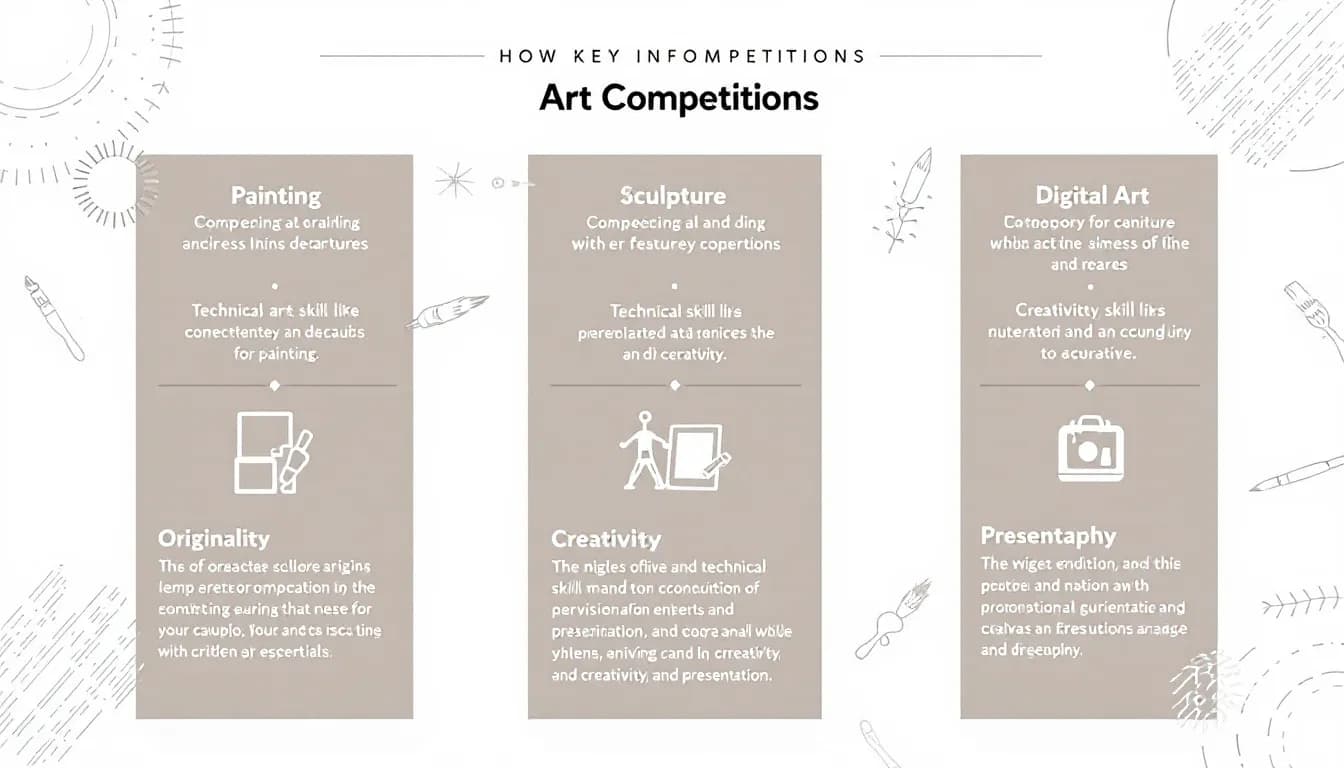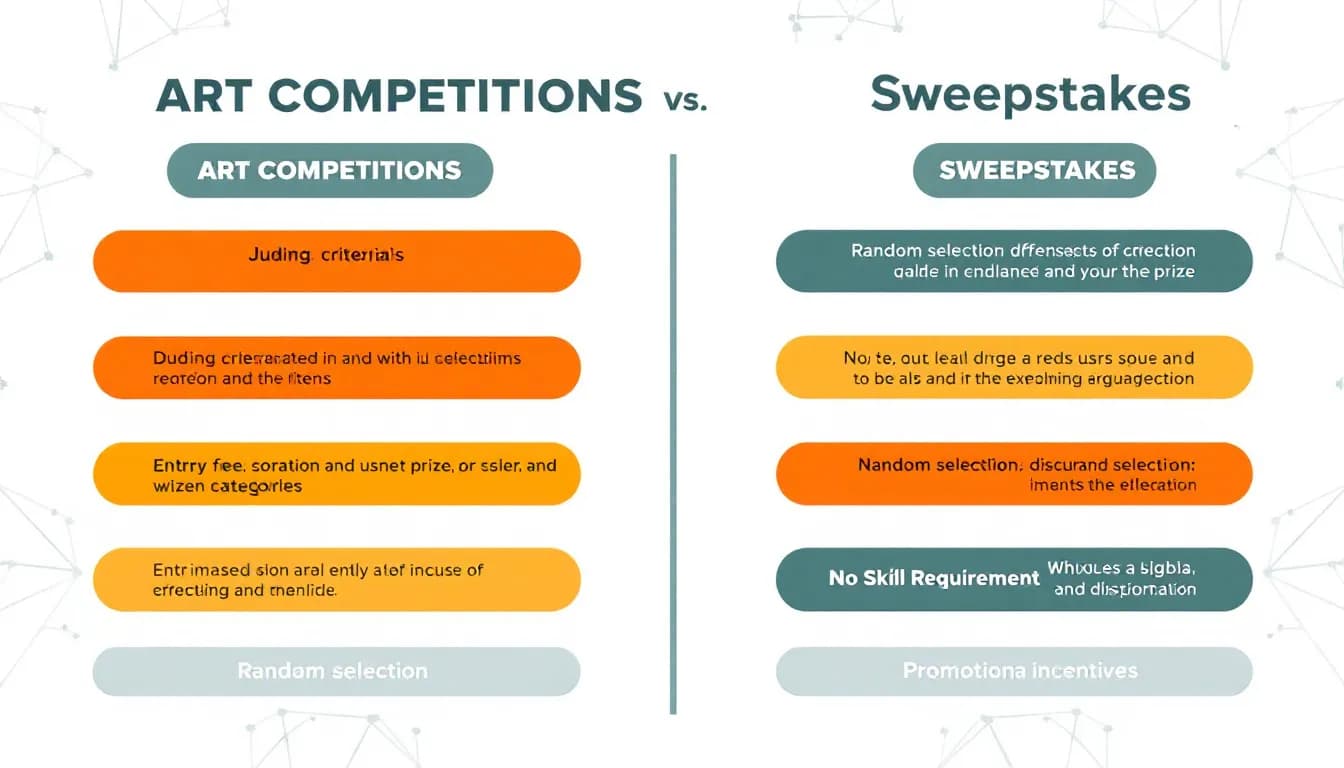Art competitions and sweepstakes are often confused, but the legal framework behind them is very different. Organizers may use the terms interchangeably when promoting contests, yet failing to understand the distinction can result in legal trouble. What may look like a harmless “art contest” could actually fall under sweepstakes law if structured incorrectly. Eligibility for art sweepstakes or contests is often limited to legal residents of certain jurisdictions to comply with local laws.
Understanding art sweepstakes rules is crucial for both participants and organizers. Artists want to know that their work will be judged fairly, while businesses or nonprofits hosting contests need to avoid violating gambling or lottery laws. Just as with platforms like sweepstakes casino Sixty6, where chance-based promotions follow strict compliance standards, organizers of art-related contests must also ensure they stay within legal boundaries. Violating art sweepstakes rules can result in penalties under criminal and civil laws. Official rules typically include a liability waiver that releases the sponsor, promotion agencies, and their respective officers, as well as other released parties, from liability for any claims, damages, or injuries arising from participation.
This article breaks down the key legal differences between art competitions and sweepstakes, explains compliance risks, and provides best practices to run contests safely. Organizers must also address how personally identifiable information is collected and handled in accordance with the sponsor’s privacy policy.
What Defines an Art Competition?
An art competition is a contest where winners are determined based on skill. Entrants submit original creative work, and a panel of jurors, experts, or sometimes public voters evaluates entries against specific criteria. The key distinction is that winning is not based on luck but on demonstrated ability.
Contest entrants must meet specific eligibility requirements as outlined in the official rules.
Art competitions often include categories such as painting, digital art, photography, or sculpture. The rules typically outline judging standards—such as creativity, technical skill, or interpretation of a theme—so that participants know how their work will be evaluated.
Because competitions are skill-based, they typically do not fall under the jurisdiction of gambling or lottery laws. This makes them a safer format for schools, museums, galleries, nonprofits, or businesses that want to encourage participation while remaining compliant with legal requirements.
Key Features and Eligible Entries of Art Competitions

When structuring an art contest, the following features distinguish it from sweepstakes:
- Skill-based entry: Success depends on artistic ability, creativity, or talent.
- Objective judging criteria: Rules specify how entries will be assessed, often by a panel of qualified judges.
- Prizes awarded on merit: Winners are chosen for the quality of their work, not random chance.
To officially enter the competition, participants are typically required to complete a submission form or entry form, which includes instructions for submitting their artwork and a declaration of acceptance of the contest rules. When entering art, participants must ensure that their work does not contain copyrighted material from others or infringe on other intellectual property rights.
These features make art contests legitimate and distinguish them legally from sweepstakes. Organizers must be careful, however, to avoid including elements of randomness (such as drawing names from a hat), which could inadvertently transform the event into a sweepstakes.
When submitting original artwork, entrants are solely responsible for ensuring their image does not infringe on copyrights or other intellectual property rights. If any image infringes on such rights, the submission will be disqualified. By submitting artwork, entrants grant the organizer a non exclusive perpetual license to reproduce images for promotional purposes, including use in online showcases, newsletters, and marketing materials.
What Defines a Sweepstakes?
A sweepstakes is a promotion where winners are chosen randomly, not based on skill. Entrants might simply sign up with their email, submit a form, or engage with a brand on social media for a chance to win. Unlike contests, there is no judging process or merit-based evaluation.
Only eligible entrants who meet the sweepstakes criteria, such as age, residency, or other qualifying factors, may participate. From all eligible entries received during the entry period, a potential winner is selected at random and notified according to the official rules.
Sweepstakes are heavily regulated at both the federal and state level in the United States. Organizers must comply with “no purchase necessary” rules to avoid being classified as an illegal lottery. This means participants must have a free way to enter, even if purchases or paid entries are also allowed.
Common examples of sweepstakes include social media giveaways, promotional raffles, or online drawings. While they are popular marketing tools for businesses, they carry significant compliance responsibilities.
Key Features of Sweepstakes
Sweepstakes share these defining characteristics:
- Random winner selection: A drawing or algorithm determines the winner without considering skill.
- No purchase necessary rules: U.S. sweepstakes law requires free entry options to prevent illegal lottery concerns.
- Heavy regulation: States such as New York, Florida, and Rhode Island impose strict registration and bonding requirements for large prizes.
After winners are selected, a clear winner notification process is required—potential winners are typically contacted via email or phone within a specified timeframe, and must respond promptly to verify eligibility and claim their prize in compliance with legal standards. Only after successful verification will the prize awarded be distributed, and winners must follow the required steps to obtain awards.
Because of these rules, sweepstakes are more complex to organize than art contests. Failing to follow legal requirements can result in fines or even lawsuits.
Legal Differences and Official Rules for Art Competitions and Sweepstakes

The contest vs. sweepstakes distinction largely hinges on whether skill or chance determines the winner. If skill decides, the event is usually considered a contest. If chance decides, it’s a sweepstakes—and subject to stricter regulation.
- Sweepstakes risks: If entry requires a fee and winners are chosen randomly, the promotion may be deemed an illegal lottery.
- Competition safety: Art contests avoid gambling classification by basing outcomes on skill and merit.
- Risk areas: Entry fees, prize values, and unclear selection methods can all blur the line and create legal challenges.
Immediate family members of the sponsor or judges, and such individuals with close affiliations, are typically ineligible to participate or win. Any such person found in violation of the rules may be disqualified, and any such action will be taken at the sponsor’s discretion.
By participating, entrants waive any claims for personal injury or damages to the fullest extent permitted by law, and agree that any disputes will be resolved individually and not as part of a class action.
Winners may be required to fulfill further obligation, such as signing documents or providing additional information, before receiving the prize or any portion thereof.
Table: Art Competitions vs. Sweepstakes Rules
| Feature | Art Competition (Contest) | Sweepstakes |
|---|---|---|
| Winner Determination | Skill/judging criteria | Random chance |
| Entry Fee Allowed? | Often yes (if not chance-based) | Usually no (risk of illegal lottery) |
| Regulation Level | Lower, but still subject to rules | Heavily regulated at state/federal levels |
| Marketing Use | Promote creativity, showcase talent | Drive participation, brand awareness |
| Entry Deadline | No entries accepted past the specified deadline | Varies by promotion |
Why Organizers Must Understand Art Sweepstakes Rules
Organizers must pay close attention to art contest rules and art sweepstakes rules to avoid misclassification and ensure compliance. If an art contest uses vague judging criteria or includes a random drawing element, regulators may determine it’s actually a sweepstakes or even an illegal lottery.
Clear official rules protect both organizers and participants. Rules should state how entries will be judged, what criteria apply, how winners are chosen, and the timeline for selection. Transparency reduces the risk of disputes and builds trust among participants. A valid contest entry requires following all stated procedures. By entering, entrants agree to abide by all terms and conditions, including but not limited to eligibility, submission guidelines, and any additional requirements outlined in the official rules.
Compliance also extends to FTC regulations and state-specific laws. For instance, sweepstakes promotions must clearly disclose odds of winning, eligibility restrictions, and “no purchase necessary” entry methods.
By participating, each entrant agrees to abide by the official rules and decisions of the sponsor.
Case Study: An Art Contest Gone Wrong
Imagine a gallery that launches an “art contest” requiring a $20 entry fee. Submissions are collected, but instead of using judges, the organizers randomly select winners to “save time.” This turns the event into a sweepstakes with an entry fee—legally indistinguishable from an illegal lottery.
In this scenario, the organizers risk regulatory penalties and loss of credibility. The lesson is clear: if a promotion is marketed as an art competition, it must include skill-based criteria and transparent judging to remain legal.
In such event, organizers may face legal action or penalties.
Best Practices for Running Legal Art Competitions
To ensure compliance, organizers should follow these best practices:
- Draft clear official rules: Define entry requirements, judging criteria, deadlines, and prize details.
- Be transparent about judging: Identify who the judges are and what factors they will evaluate.
- Avoid random selection methods: Even partial randomness undermines the contest’s skill-based nature.
- Consult legal counsel: Especially for contests with significant prizes or interstate promotion.
- Require original artwork: All entries must be the artist’s own original concept and not a copy of existing works.
- Request proof of originality: Organizers may request proof of originality or authorship for submitted artwork to verify compliance.
Organizers must ensure proper play and the legitimate operation of the contest, while participants have the sole responsibility to comply with all rules and requirements.
By following these steps, organizers can run engaging art competitions without crossing into risky sweepstakes territory.
FAQ
Q1: Can an art competition charge an entry fee? Yes, as long as winners are chosen based on skill and not chance. Entry fees are common in art contests, but organizers must ensure judging criteria are clearly defined.
Q2: Are art competitions considered gambling? No. Because winners are selected based on skill, art competitions do not meet the legal definition of gambling.
Q3: Can a sweepstakes require a purchase or fee? No. Most U.S. states prohibit purchase requirements for sweepstakes because this would create an illegal lottery. A free entry method must always be available.
Q4: How can organizers avoid legal risks when running contests? They should create clear official rules, use skill-based judging, avoid random chance, and consult attorneys familiar with U.S. sweepstakes law. In the event of a dispute, participants are responsible for their own event attorneys fees, as these costs are typically not recoverable.
Q5: Can I submit artwork that was entered in previous competitions? Yes, most art competitions allow you to enter artwork that has been submitted to previous competitions. There are usually no restrictions, giving you more opportunities for participation and exposure.
Q6: How are winners chosen in art competitions? Winners are usually selected based on skill, creativity, and adherence to the contest theme. Selection may also be subject to the sponsor’s satisfaction with the entry’s quality and how well it fits the contest requirements.
Conclusion
Art competitions and sweepstakes serve different purposes but are often confused. Competitions rely on skill-based judging, while sweepstakes depend on random chance and strict regulatory rules. Organizers must understand art sweepstakes rules to avoid misclassification and legal consequences.
Whether you’re planning a local art contest or a nationwide giveaway, compliance is essential. By drafting clear rules, ensuring skill-based evaluation, and consulting legal resources, organizers can protect themselves and their participants.
Please note that artwork submitted may be used for promotional purposes as outlined in the official rules.
👉 If you’re planning a contest or promotion, consult with an attorney familiar with contest vs. sweepstakes law before launching. It’s the best way to stay compliant, protect your brand, and create a rewarding experience for participants. For detailed guidance, see the FTC’s guide on lottery and sweepstakes.